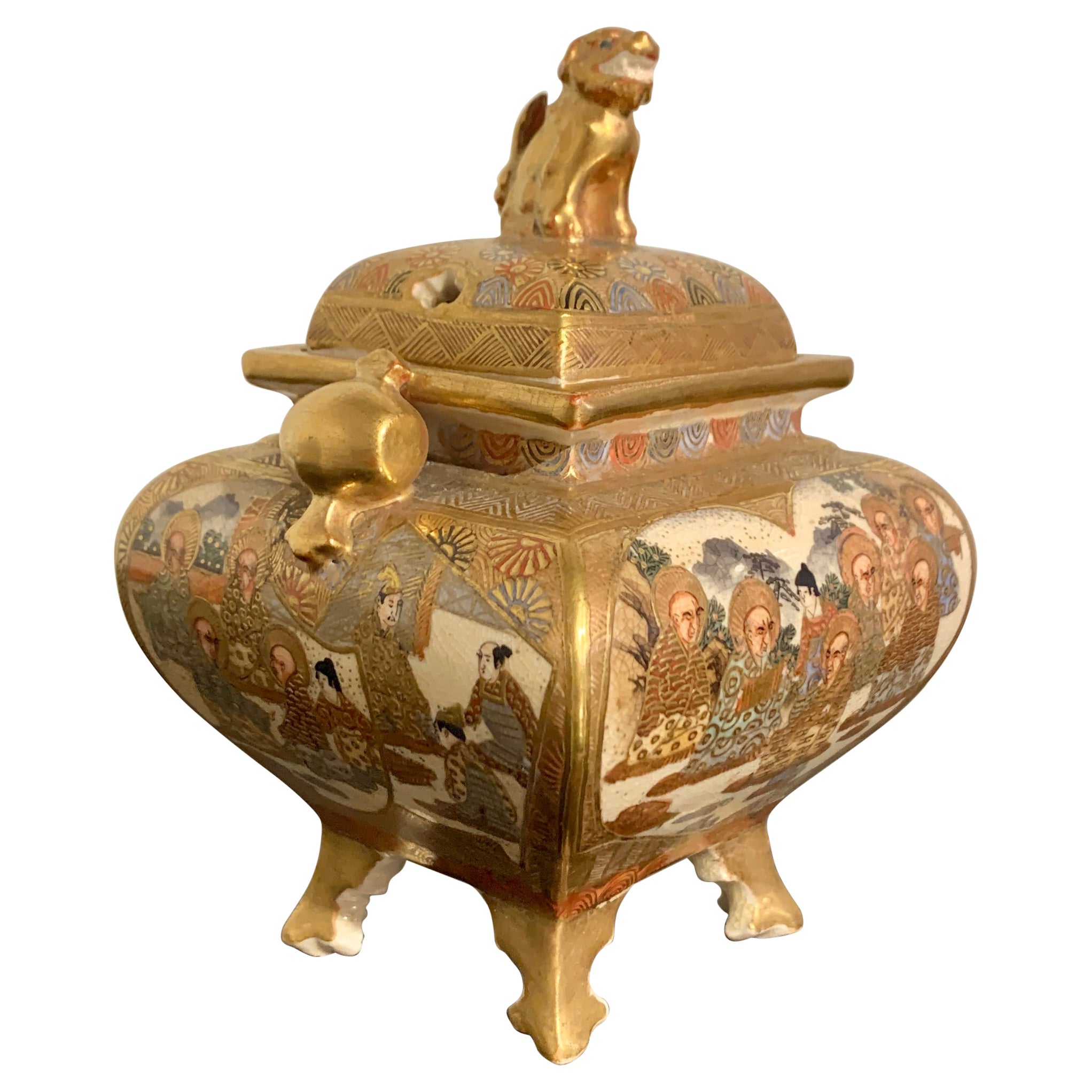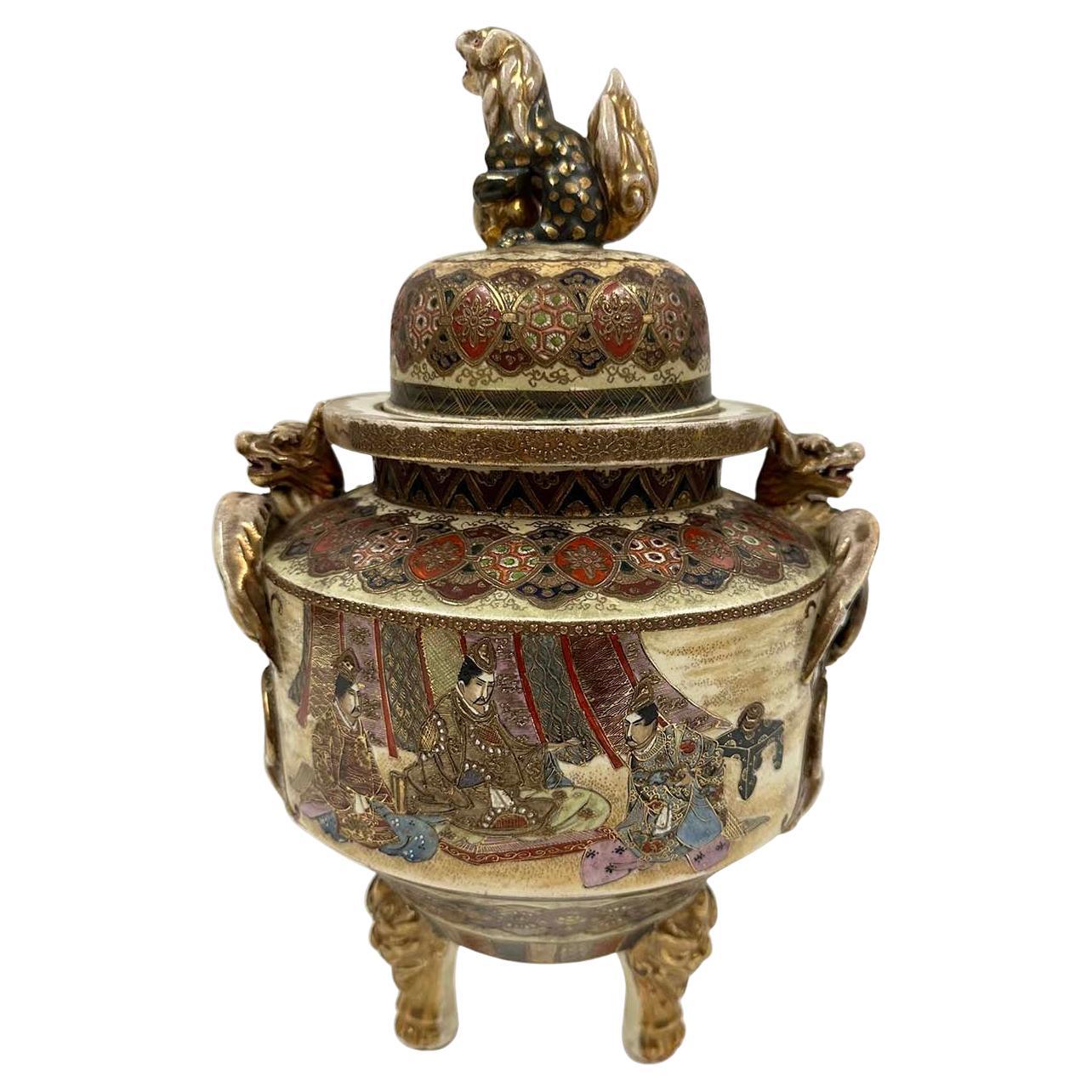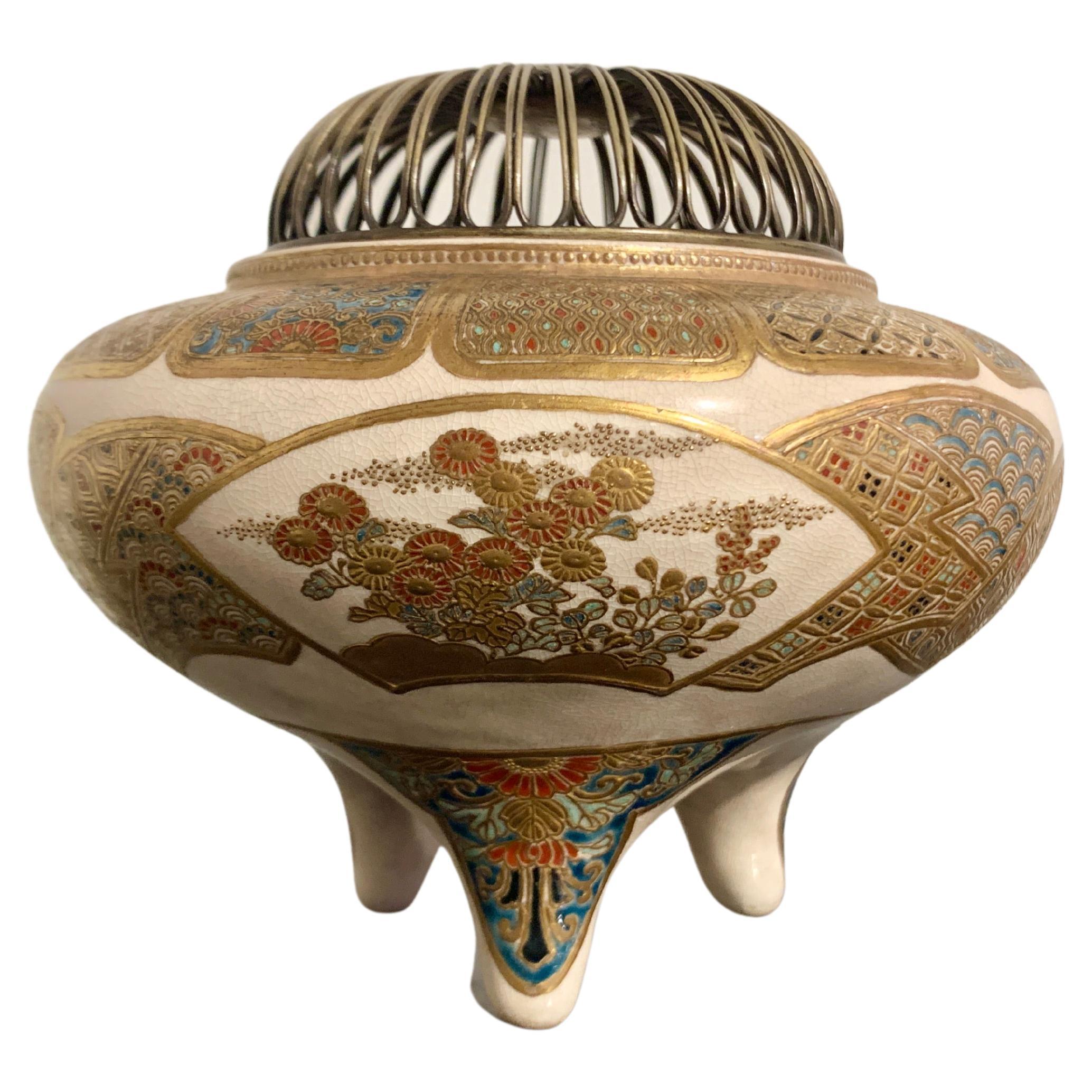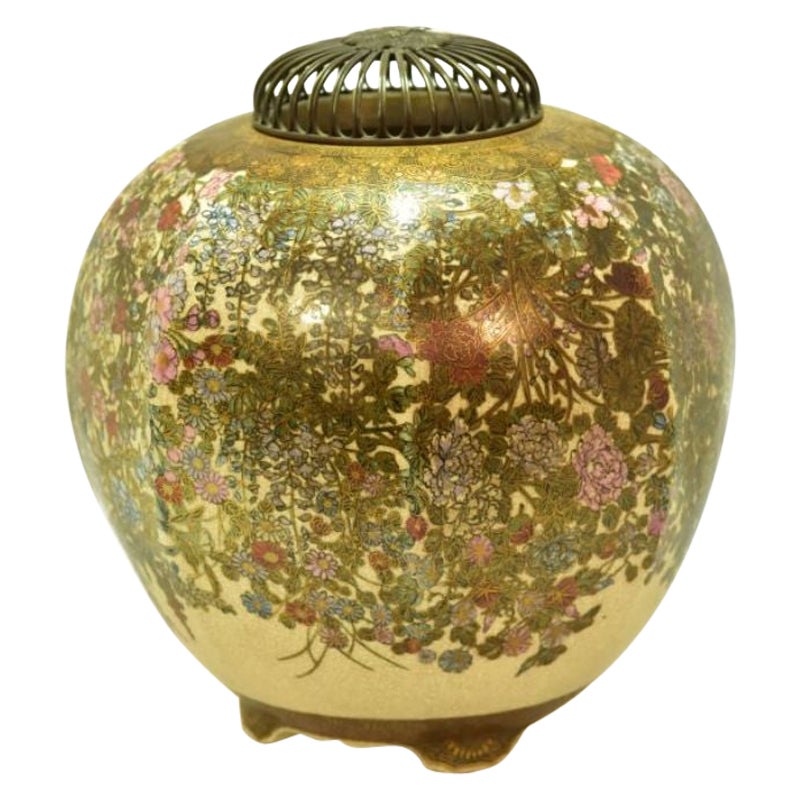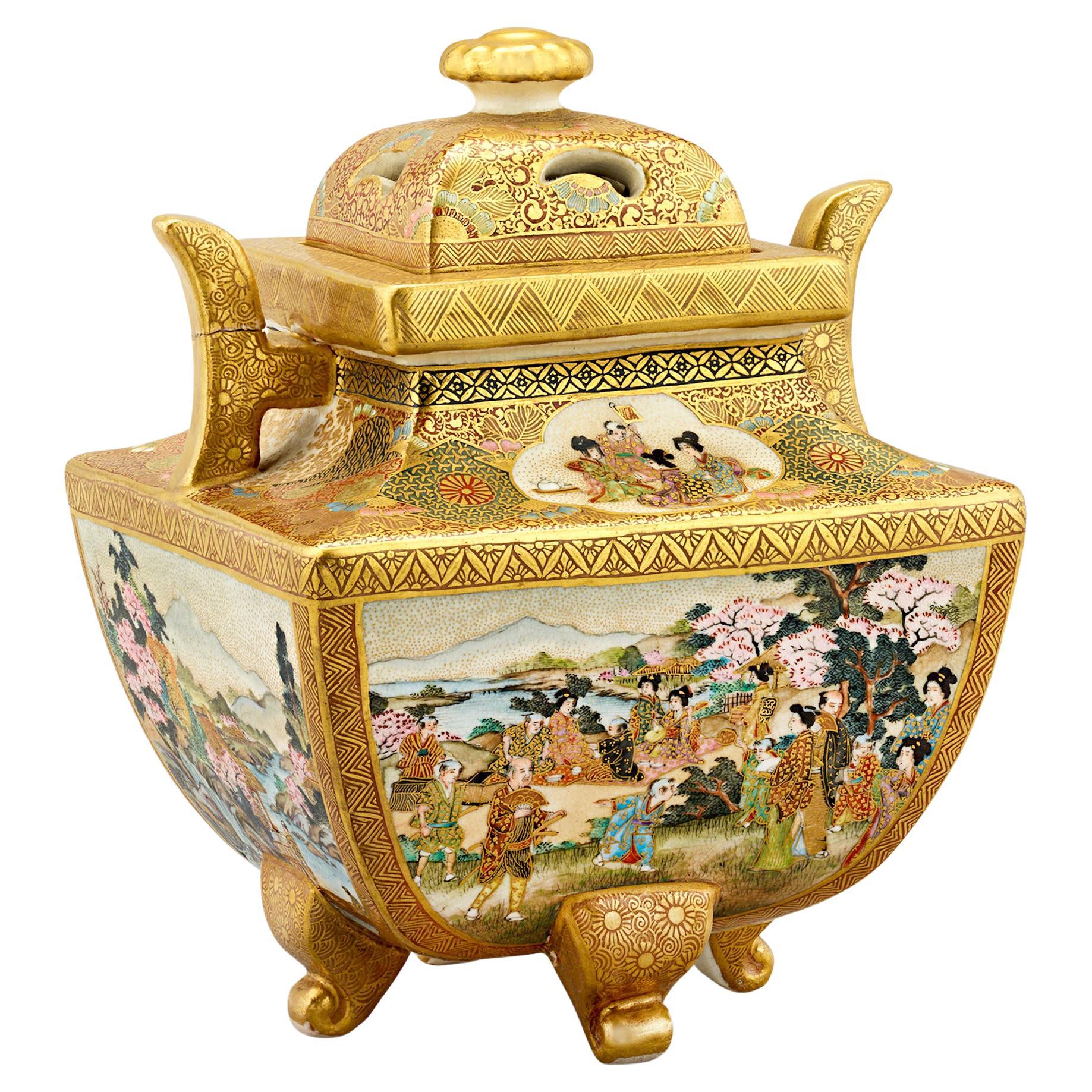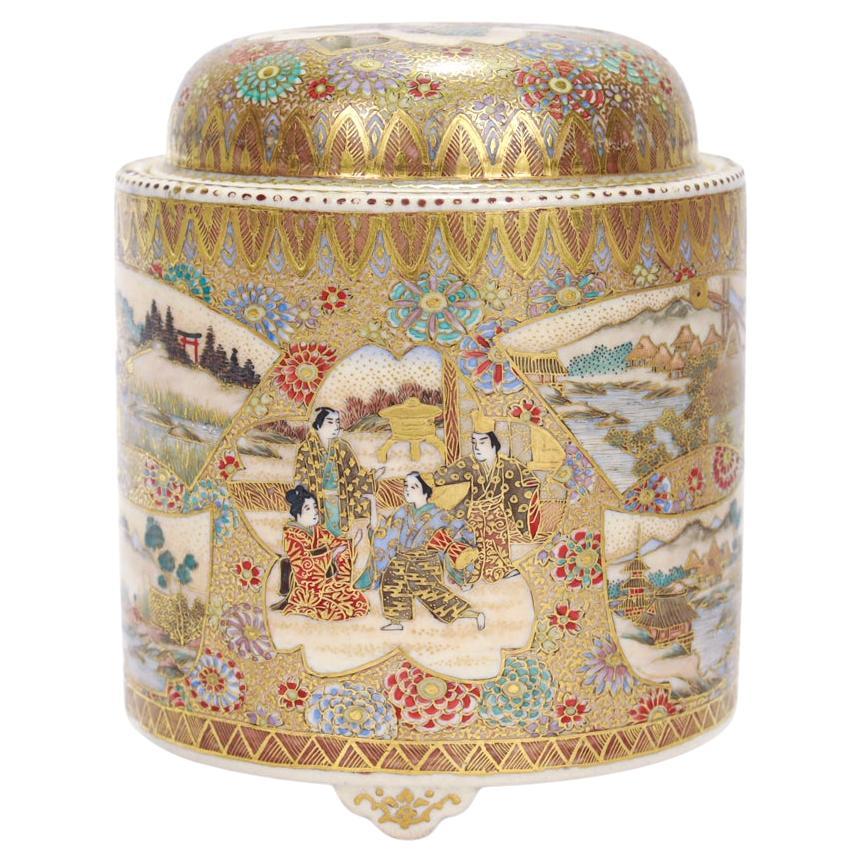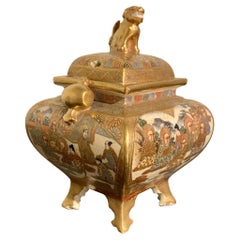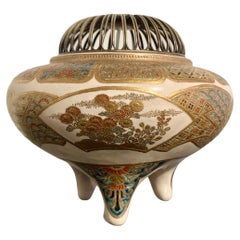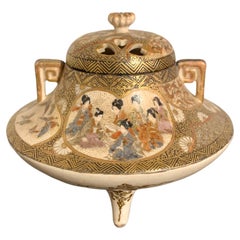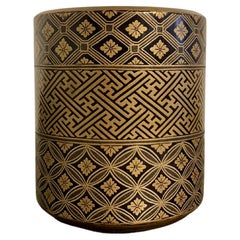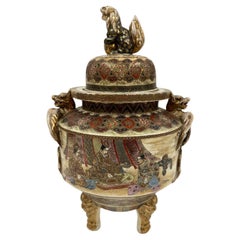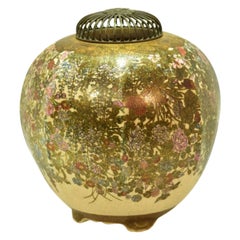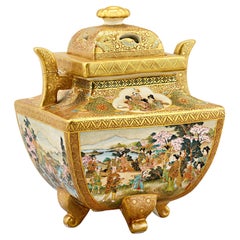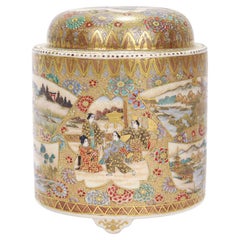Items Similar to Japanese Satsuma Incense Burner, Koro, with Silver Lid, Meiji Period, Japan
Want more images or videos?
Request additional images or videos from the seller
1 of 16
Japanese Satsuma Incense Burner, Koro, with Silver Lid, Meiji Period, Japan
$2,400
£1,834.93
€2,113.47
CA$3,363.14
A$3,754.62
CHF 1,967.37
MX$45,960.29
NOK 24,985.58
SEK 23,558.23
DKK 15,773.01
About the Item
A fantastic Japanese Satsuma incense burner, koro, with phoenix and brocade designs and a silver lid, Meiji Period, late 19th century, Japan.
The censer, called a koro in Japan, of generous barrel form, and set on a recessed foot raised on three short feet and surmounted by a pierced repousse sliver cover.
The barrel shaped body of generous proportions and decorated in an exuberant fashion. Three large reserves feature stylized confronted phoenixes perched upon a mon comprised of phoenix wings.
Surrounding the reserves are scattered brocade designs of intricate and elaborate patterns. Motifs include chrysanthemum, peony, ginger, fern, pine cones, and tortoise shell.
The shoulder features a band of stylized chrysanthemum within a ruyi-shaped cloud border. The foot features a delicate band of stylized lotus petals.
The pierced repousse silver cover of the koro worked with a chrysanthemum leaf design to the top. The sides with stylized chrysanthemum blooms within arched niches that line up with the ruyi cloud border of the shoulder. A masterful and extremely difficult technical feat.
Unmarked.
- Dimensions:Height: 6 in (15.24 cm)Diameter: 5 in (12.7 cm)
- Style:Meiji (Of the Period)
- Materials and Techniques:
- Place of Origin:
- Period:
- Date of Manufacture:circa 1890
- Condition:Wear consistent with age and use. Minor fading. No chips, cracks, or repairs noted. Very slight rubbing and wear to the gilding. The silver with tarnish.
- Seller Location:Austin, TX
- Reference Number:1stDibs: LU894744335422
About the Seller
5.0
Platinum Seller
Premium sellers with a 4.7+ rating and 24-hour response times
Established in 2001
1stDibs seller since 2010
345 sales on 1stDibs
Typical response time: <1 hour
- ShippingRetrieving quote...Shipping from: Austin, TX
- Return Policy
Authenticity Guarantee
In the unlikely event there’s an issue with an item’s authenticity, contact us within 1 year for a full refund. DetailsMoney-Back Guarantee
If your item is not as described, is damaged in transit, or does not arrive, contact us within 7 days for a full refund. Details24-Hour Cancellation
You have a 24-hour grace period in which to reconsider your purchase, with no questions asked.Vetted Professional Sellers
Our world-class sellers must adhere to strict standards for service and quality, maintaining the integrity of our listings.Price-Match Guarantee
If you find that a seller listed the same item for a lower price elsewhere, we’ll match it.Trusted Global Delivery
Our best-in-class carrier network provides specialized shipping options worldwide, including custom delivery.More From This Seller
View AllSmall Japanese Satsuma Incense Burner, Koro, Meiji Period, Late 19th Century
Located in Austin, TX
A fine Japanese Satsuma stoneware incense burner, koro, Meiji Period, late 19th century, Japan.
The koro of square shape with curved sides,...
Category
Antique 1890s Ceramics
Materials
Enamel
Japanese Satsuma Incense Burner, Koro, Meiji Period, Late 19th Century, Japan
Located in Austin, TX
A fine and elegant Japanese Satsuma tripod incense burner, koro, with pierced metal lid, signed Eizan (?) Meiji Period, late 19th century, Japan.
The koro, or censer, features a stoneware body of slightly compressed globular form, supported on three short and squat legs. The wide mouth with a recessed metal rim, and topped by an openwork metal lid topped with overlapping chrysanthemum blossoms of silver repousse.
The body of the koro finely painted with fan shaped cartouches. The fans in the foreground with sprays of blossoming chrysanthemum. The fans in the background with intricate geometric brocade designs.
The shoulder of the incense burner decorated with cartouches formed as stylized chrysanthemum petals, and intricately decorated with geometric and floral brocade designs.
The painting finely done in raised gilt and polychrome enamels, including the highly desirable gosu blue...
Category
Antique Late 19th Century Japanese Meiji Ceramics
Materials
Silver, Metal
Japanese Satsuma Tripod Censer, Koro, Meiji period, Early 20th Century, Japan
Located in Austin, TX
A small and finely decorated Japanese Satsuma tripod incense burner (koro), signed Kyozan, Meiji period, circa 1900, Japan.
The censer, koro, with a compressed body supported by t...
Category
Antique Early 1900s Japanese Meiji Ceramics
Materials
Stoneware
Japanese Lacquer Incense Burner, Koro, Edo period, mid 19th century, Japan
Located in Austin, TX
An elegant and refined Japanese lacquer koro, incense burner, in the form of a chaire, tea caddy, Edo Perio, mid 19th century, Japan.
The barrel shaped koro formed as a traditional ...
Category
Antique Mid-19th Century Japanese Edo Lacquer
Materials
Copper
Japanese Silver Incense Burner, Akoda Koro, by Nomura, Meiji Period, Japan
Located in Austin, TX
A lovely and luxurious Japanese silver incense burner of lobed melon form, akoda koro, marked jungin and signed Nomura, Meiji Period, circa 1900, Japan.
The silver koro...
Category
Vintage 1910s Japanese Meiji Metalwork
Materials
Silver, Sterling Silver
Chinese Cloisonne Incense Burner, circa 1960's, China
Located in Austin, TX
A fine and beautifully enameled Chinese cloisonne incense burner, censer, with pierced cover, mid 20th century, circa 1960's, China.
The ce...
Category
Vintage 1960s Chinese Qing Metalwork
Materials
Copper, Enamel
You May Also Like
Antique Japanese Meiji Period Satsuma Incense Burner Censer
Located in Pomona, CA
UP for you consideration is a beautiful antique Meiji period Japanese gold gilt satsuma incense burner marked/signed by Kinkozan. Very fine hand...
Category
Early 20th Century Japanese Chinese Export Urns
Materials
Porcelain
Incense Burner in Satsuma Earthenware
Located in Marseille, FR
JAPAN - Circa 1900 Incense burner in Satsuma earthenware with vegetal decoration. Openwork lid in shibuichi surmounted by a flower in slight relief...
Category
Antique 19th Century Japanese More Asian Art, Objects and Furniture
Materials
Earthenware
Satsuma Incense Burner
Located in New Orleans, LA
This Japanese Satsuma incense burner is a decorative work of art from the Meiji period, distinguished by its exquisite craftsmanship and intricate detailing. Made from fine earthenwa...
Category
Antique 19th Century Japanese Meiji Ceramics
Materials
Earthenware
$3,450
Miniature Antique Japanese Satsuma Pottery Censer or Koro
By Kinkozan
Located in Philadelphia, PA
A fine antique Japanese Satsuma pottery incense burner.
With a cream ground and an extensively gilt exterior.
There are numerous cartouches around the censer with each having a un...
Category
Early 20th Century Meiji Ceramics
Materials
Pottery
A Satsuma Earthenware Incense Burner by Yabu Meizan, Osaka, 1853-1934
By Satsuma
Located in West Palm Beach, FL
A Satsuma Earthenware Incense Burner by Yabu Meizan,
Osaka, 1853-1934,
Of archaic Chinese form set on tripod feet and decorated in polychrome enamels and gilt...
Category
Antique Early 1900s Vases
Materials
Earthenware
Japanese Bronze and Sterling Incense Burner from Takaoka
Located in Louisville, KY
This stunning Koro was crafted in Takaoka, Japan where craftsmen use intricate tooling and expert kills to create the delicate details found in this piece. Crafted of bronze, this Ko...
Category
20th Century Japanese Other Metalwork
Materials
Sterling Silver, Bronze
More Ways To Browse
1890 Japan
Japanese Silver Leaf
Japanese Phoenix
Chrysanthemum Pattern
Lotus Ceramics
Satsuma Japan Porcelain
Design Technics Pottery
Covered Barrel
Unmarked Pottery
Meiji Porcelain Satsuma
Japanese Shell Art
Satsuma Pottery
Japanese Satsuma Pottery
Ceramic Barrel
Pierced Pottery
A Large Tortoise Shell
Large Incense Burner
Shell Niche
